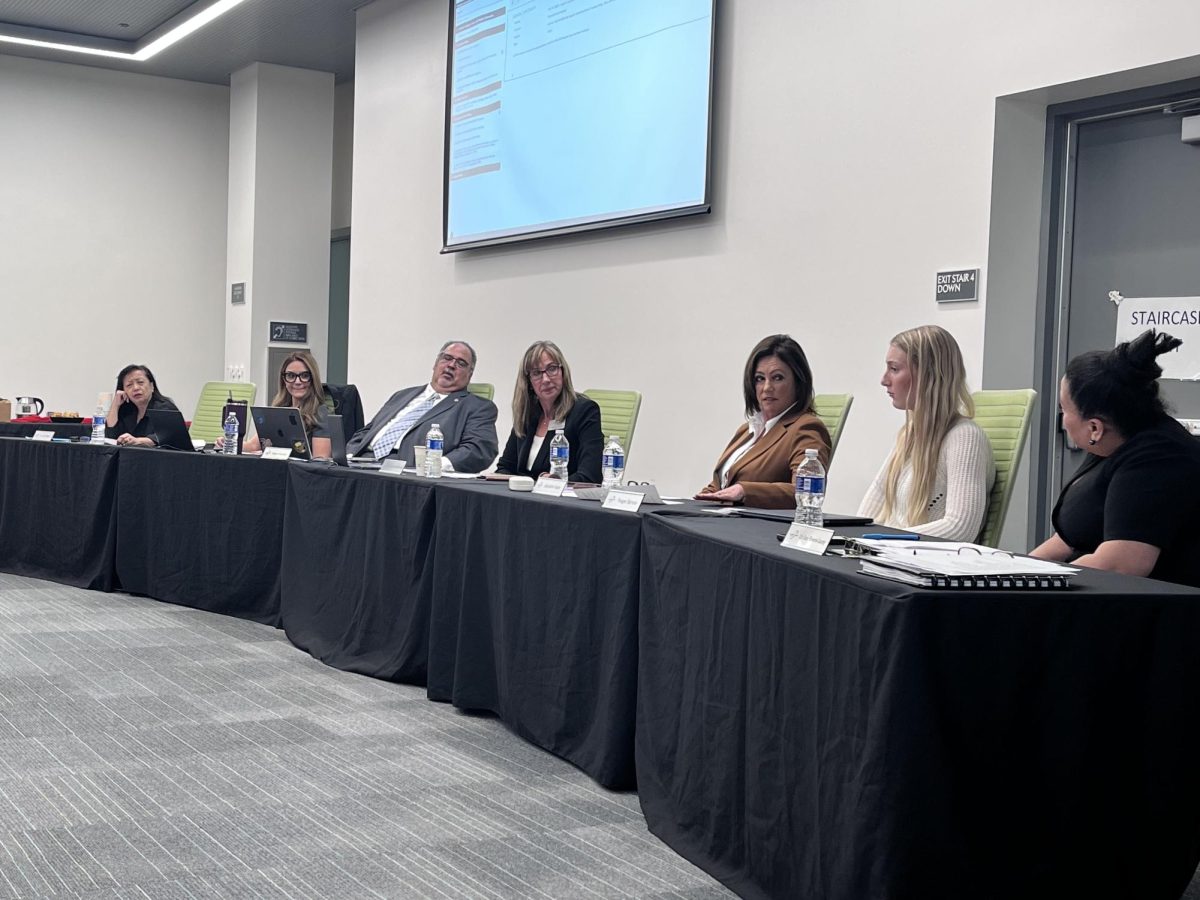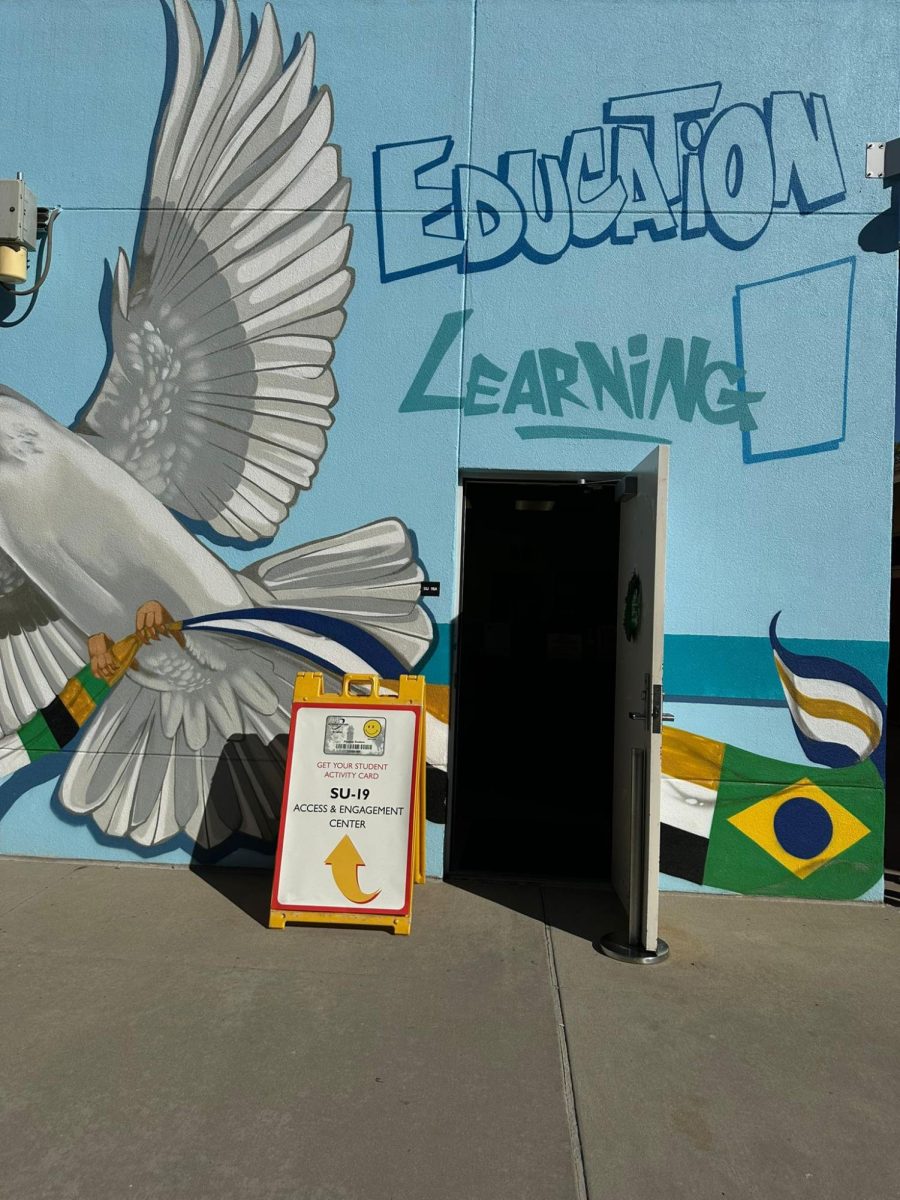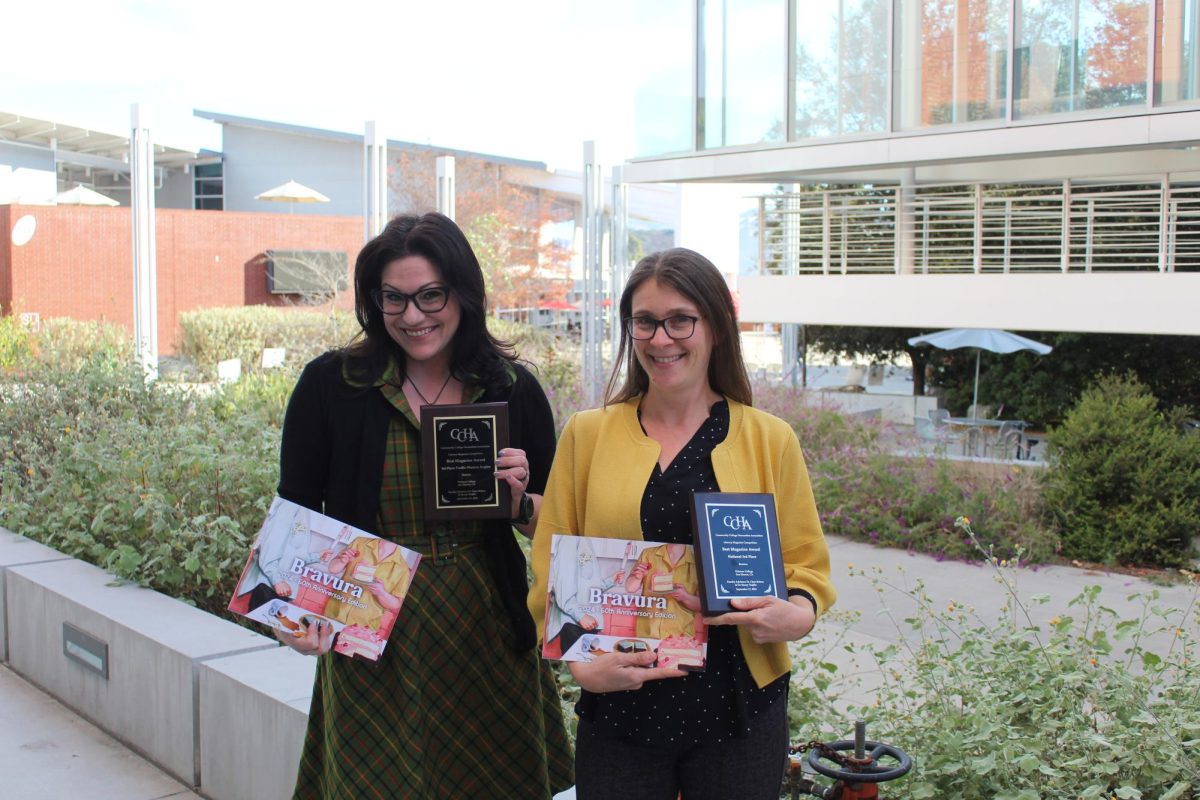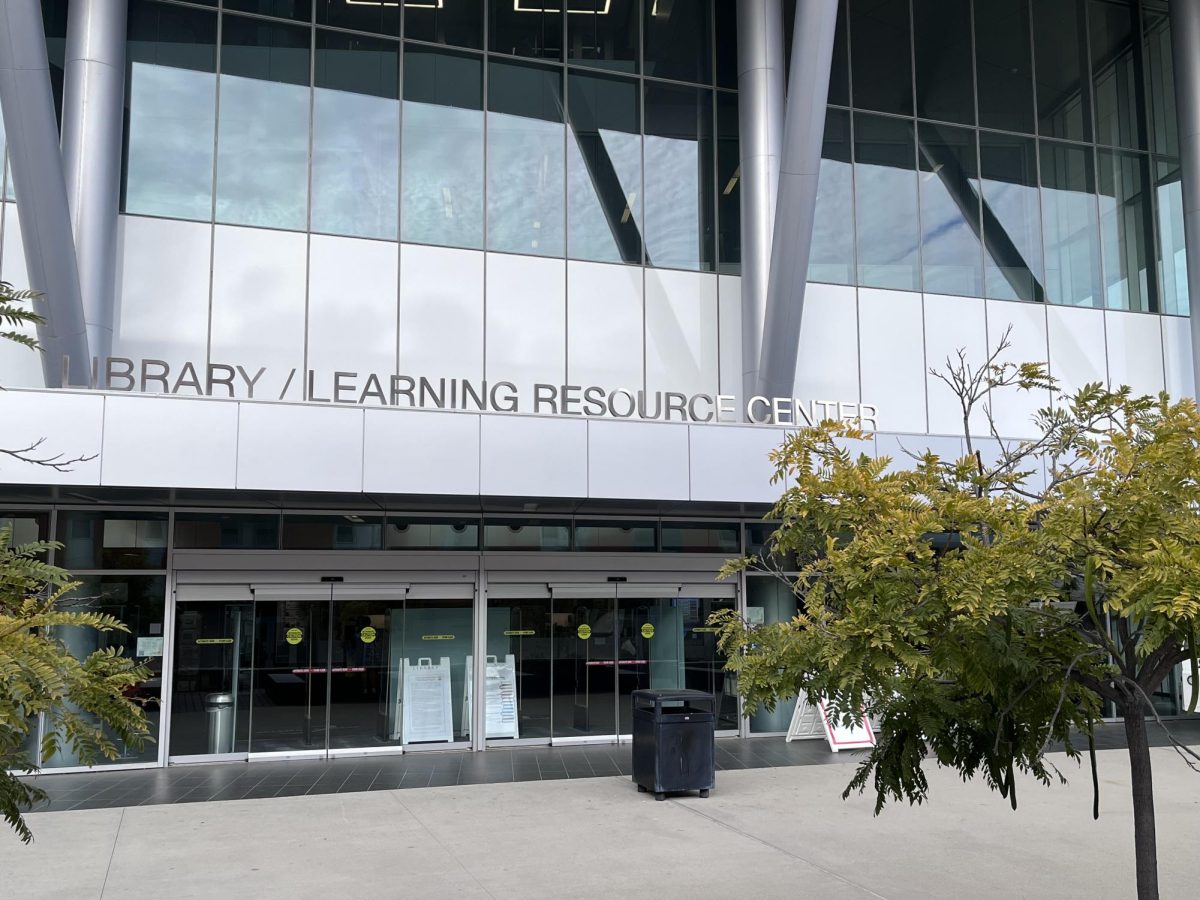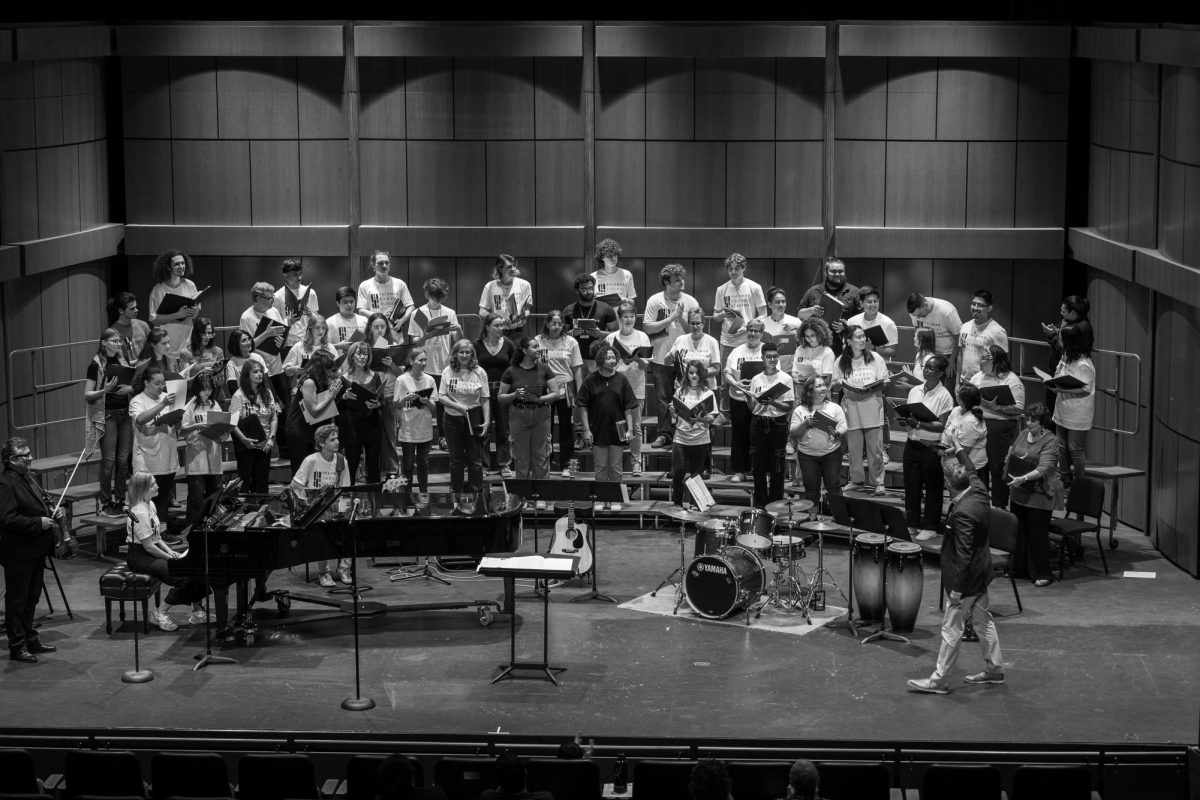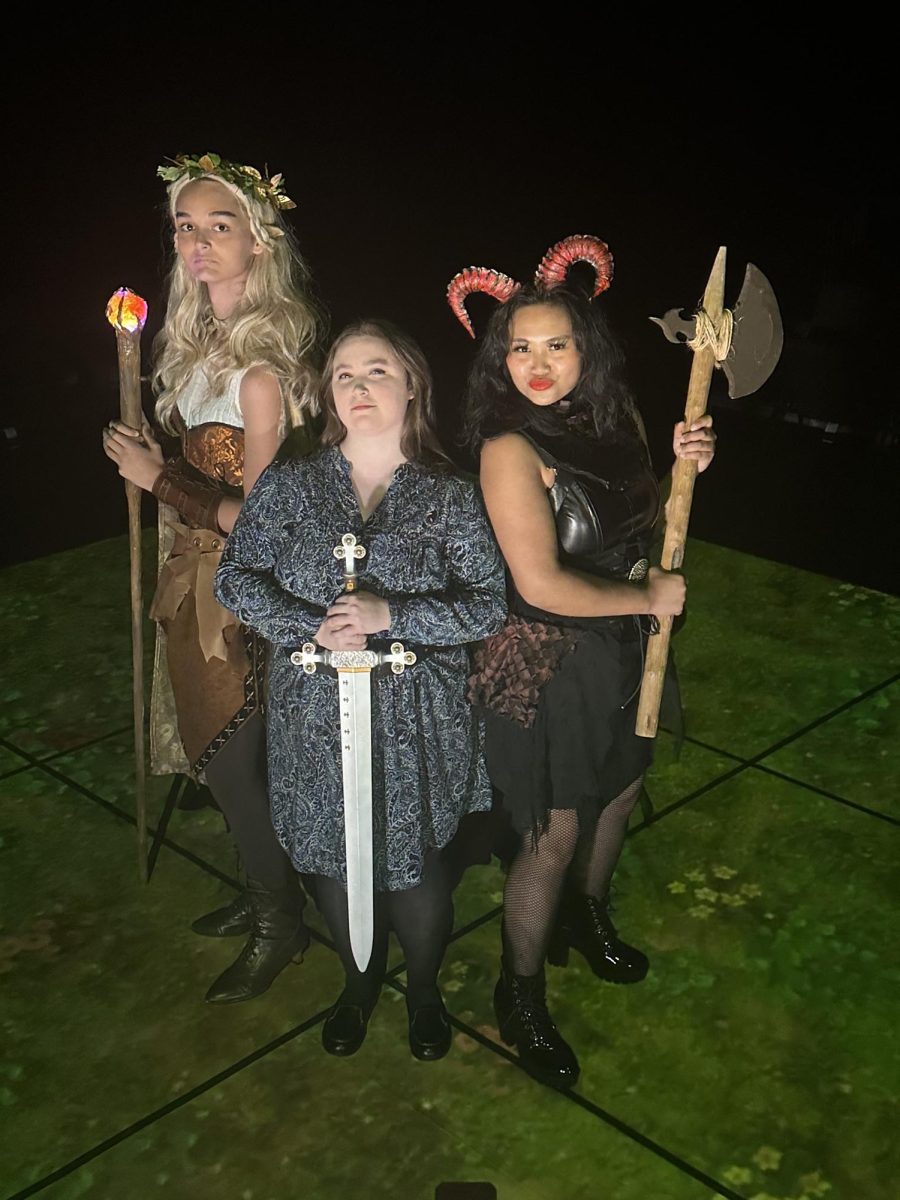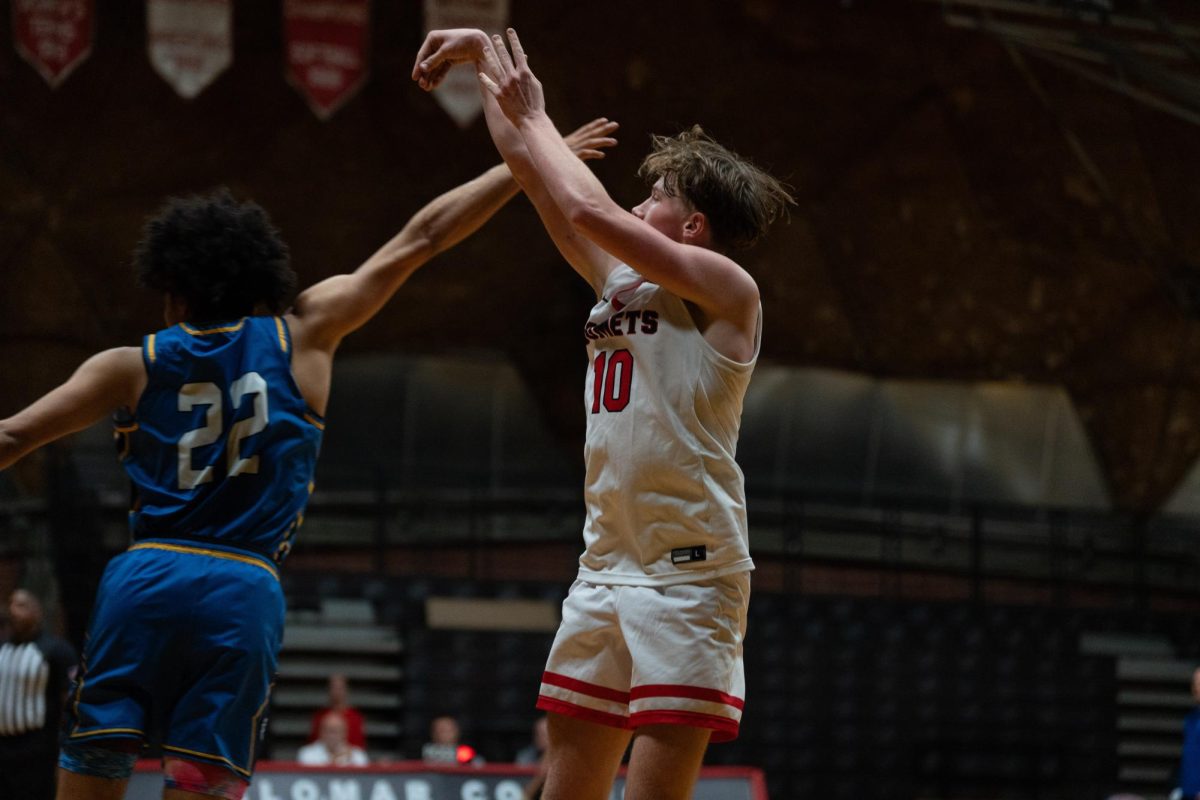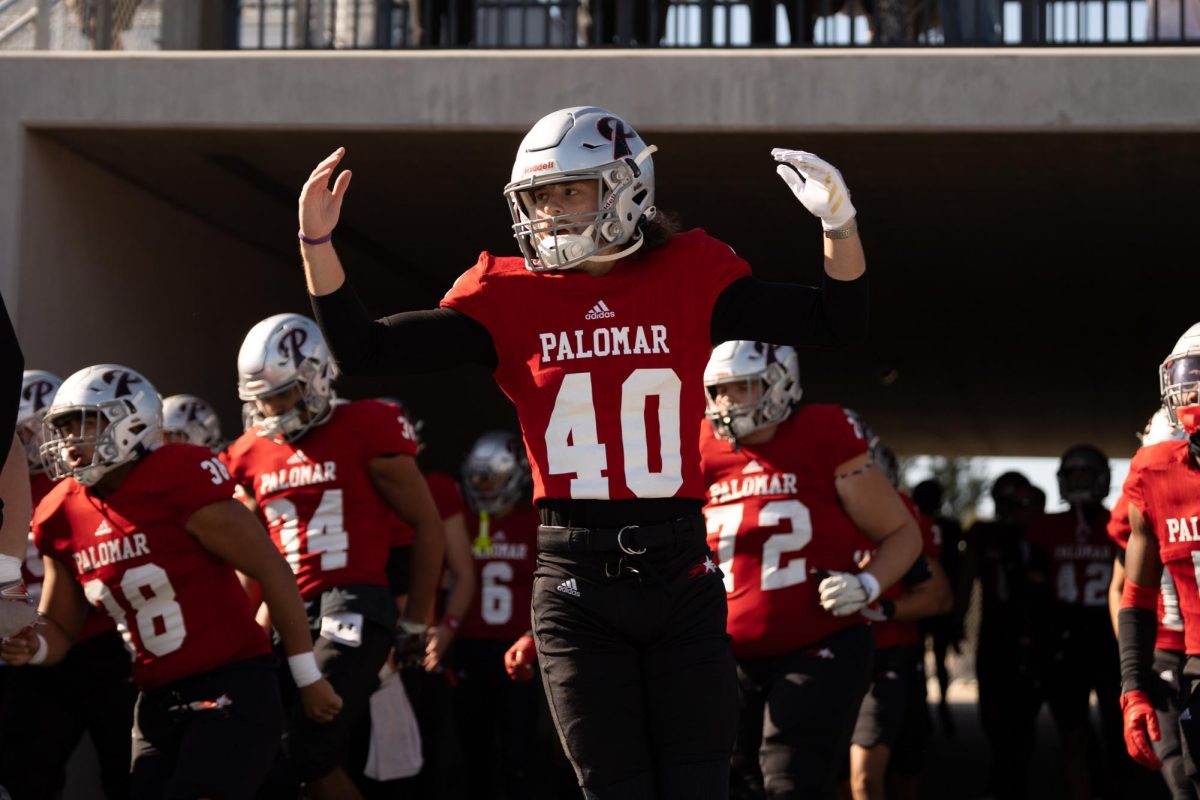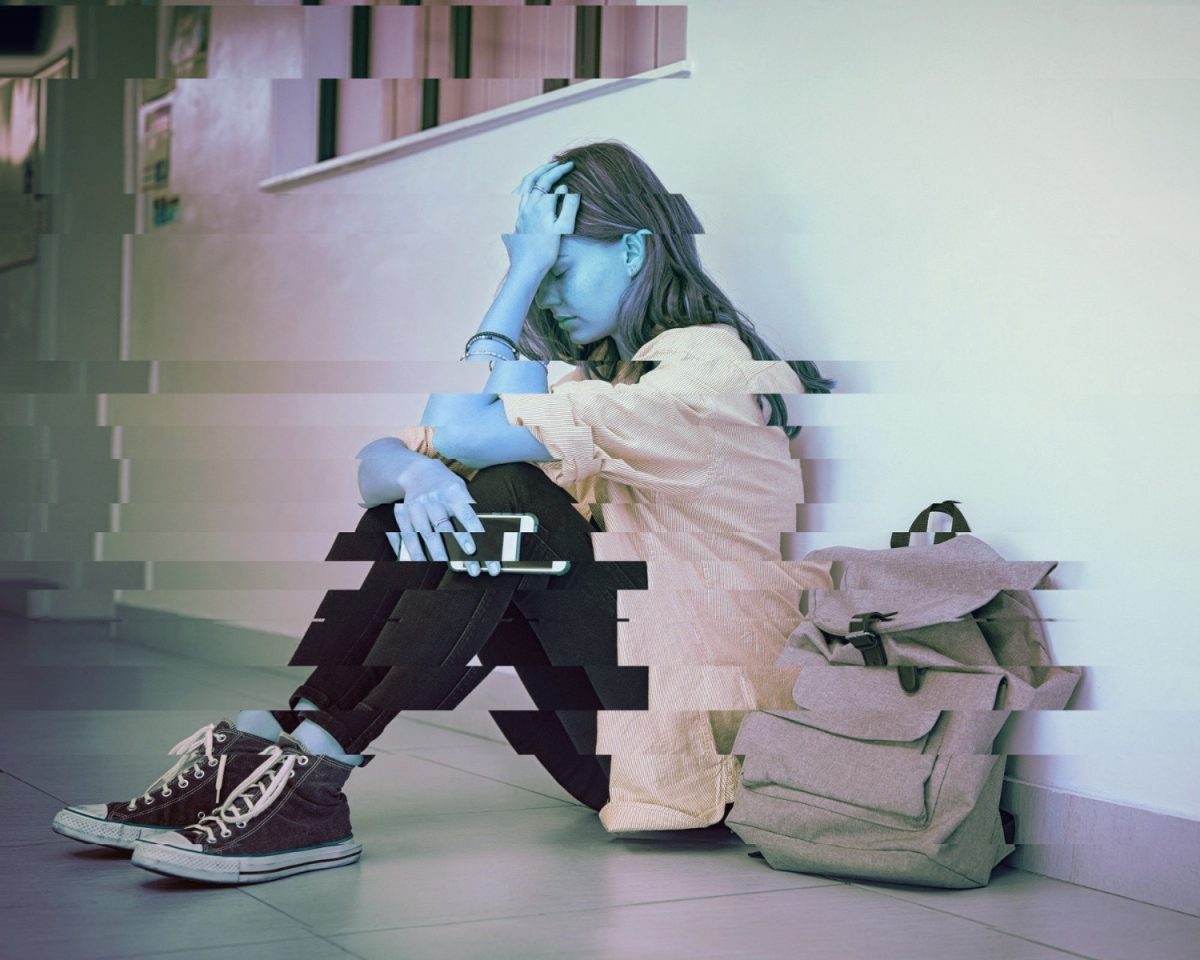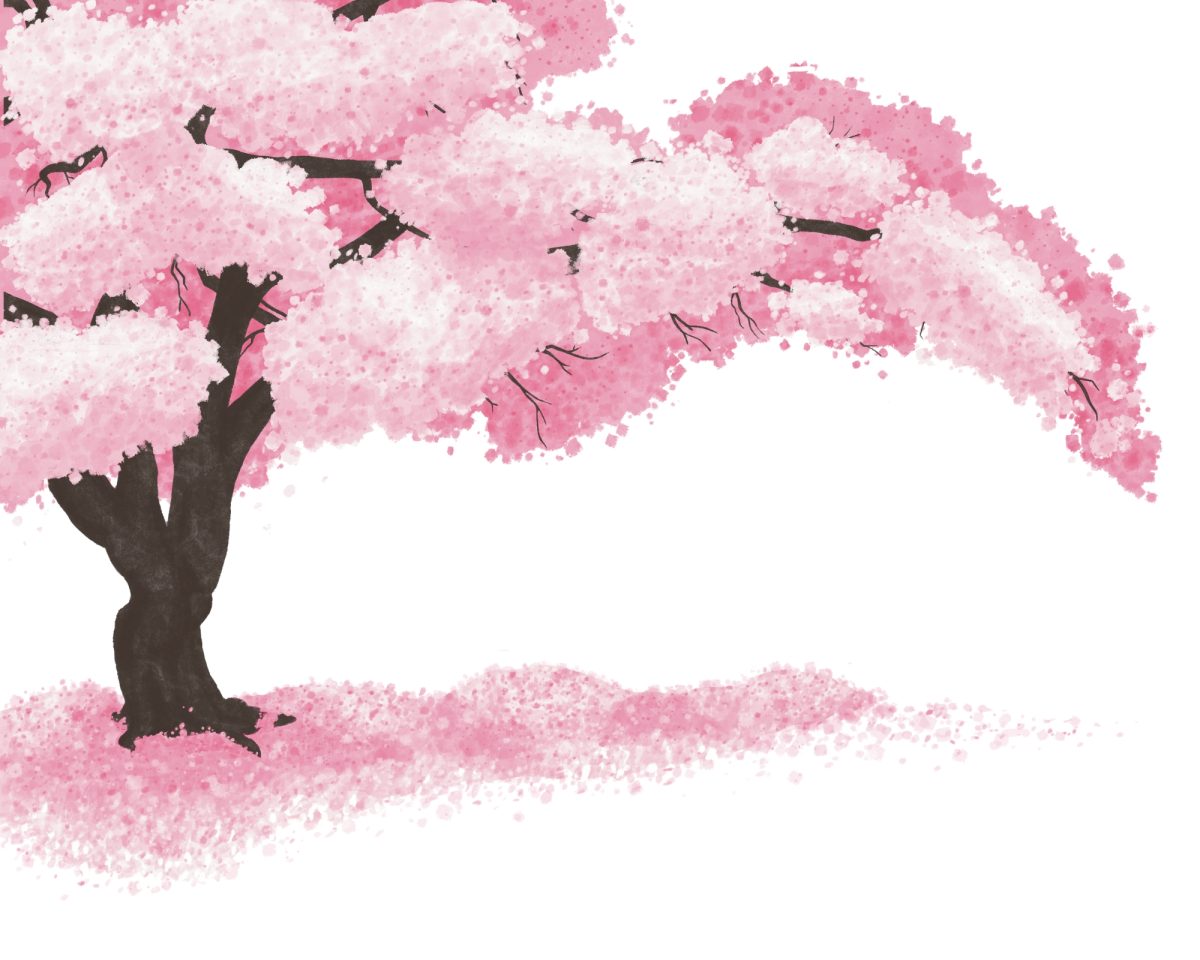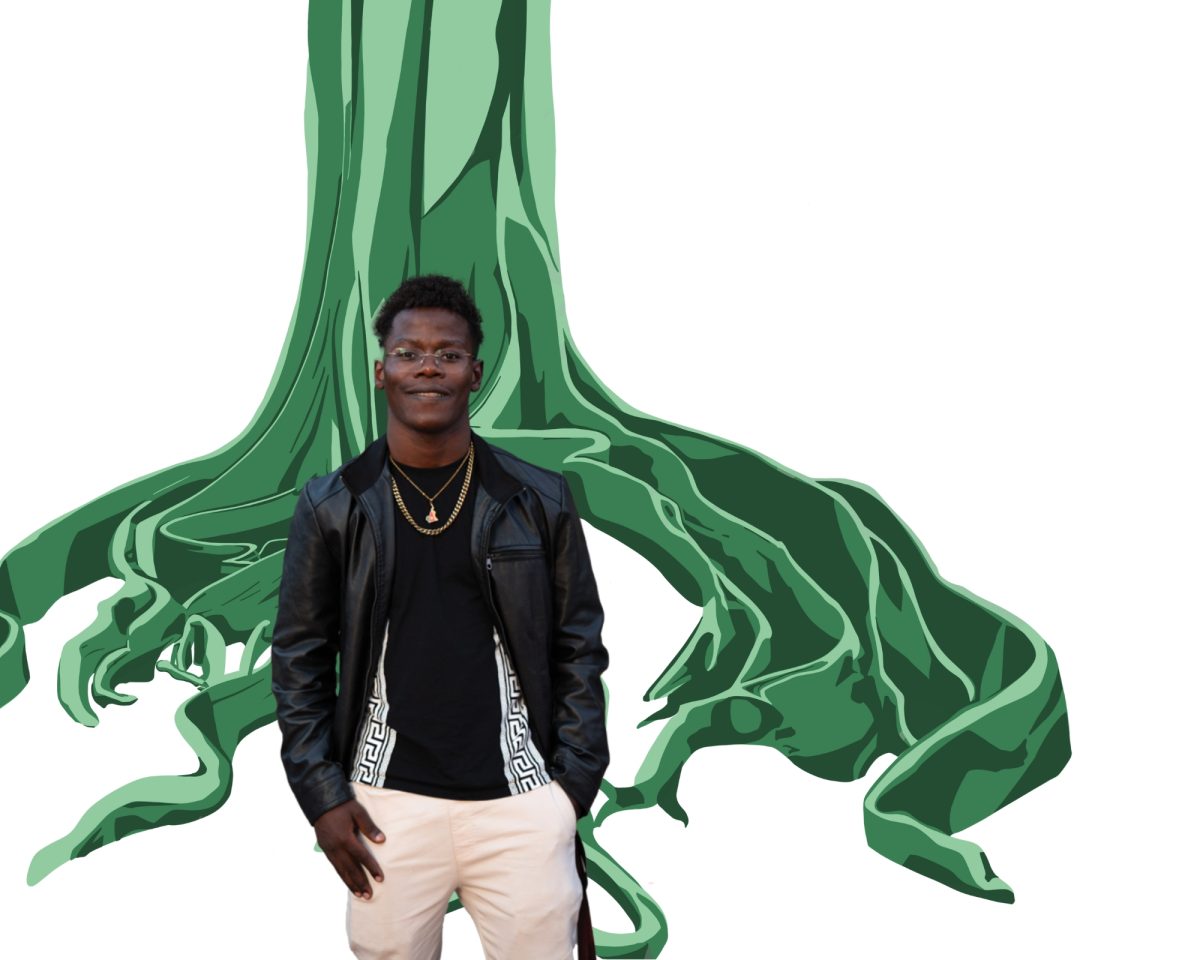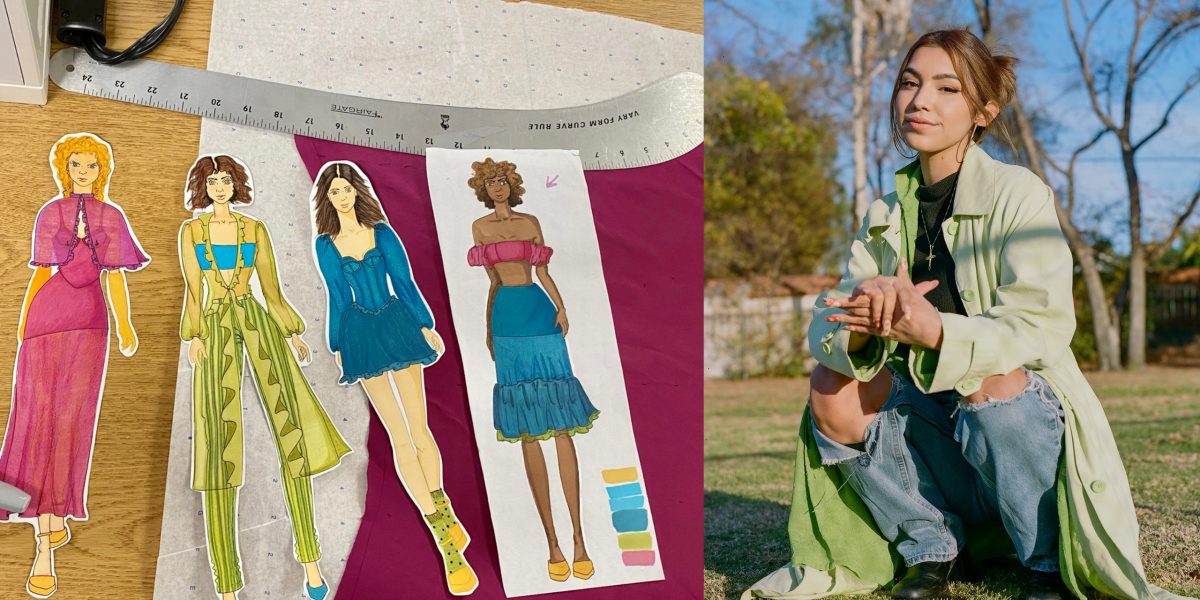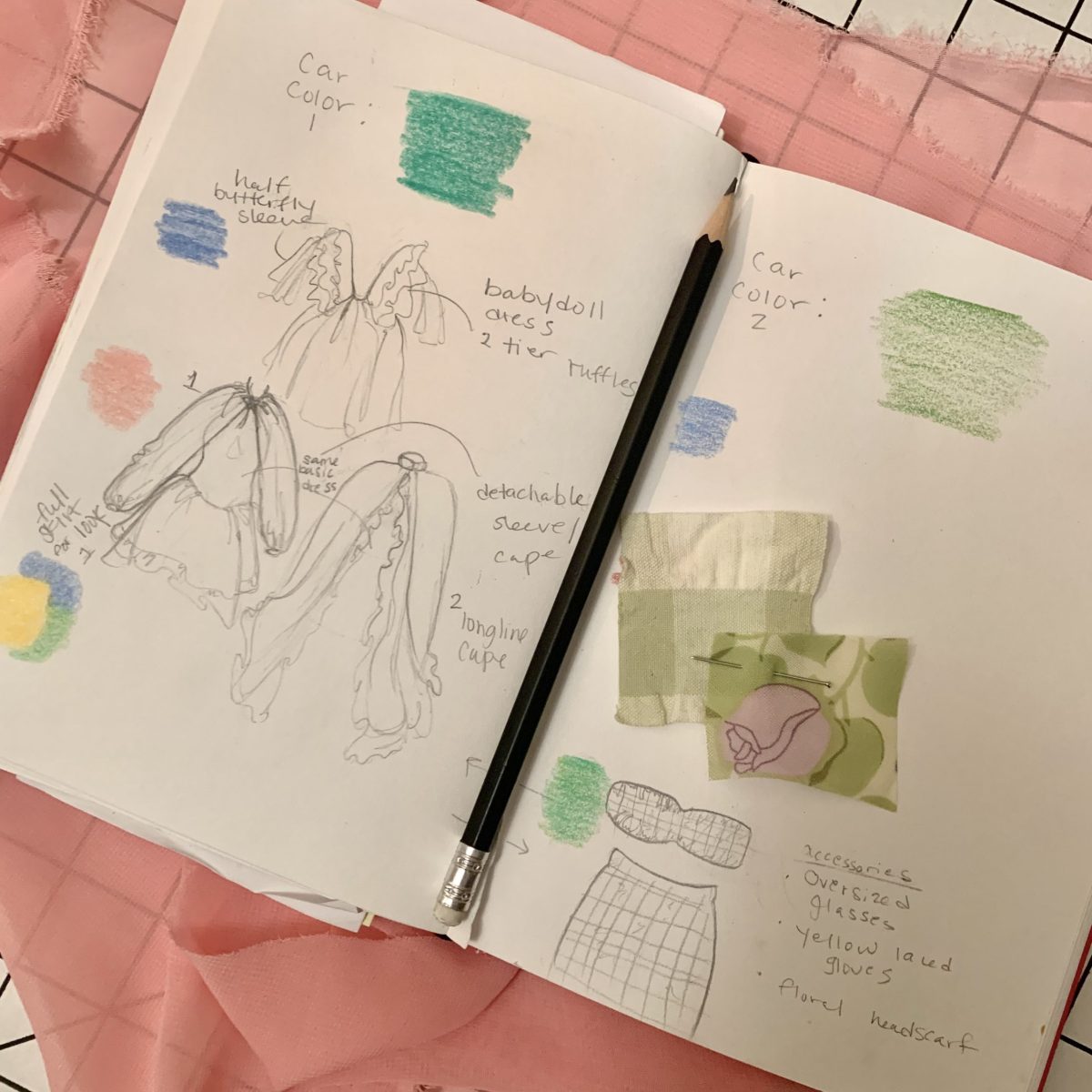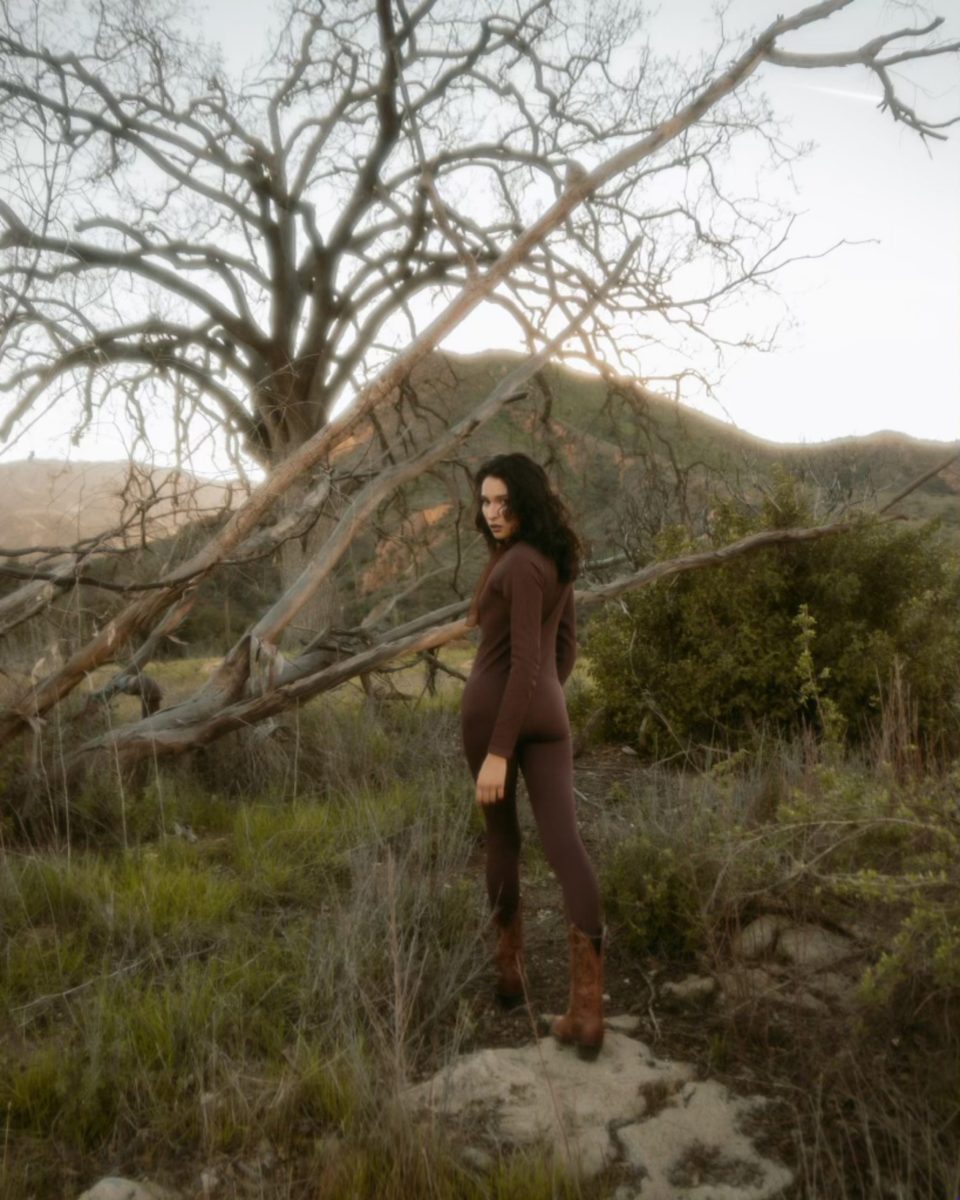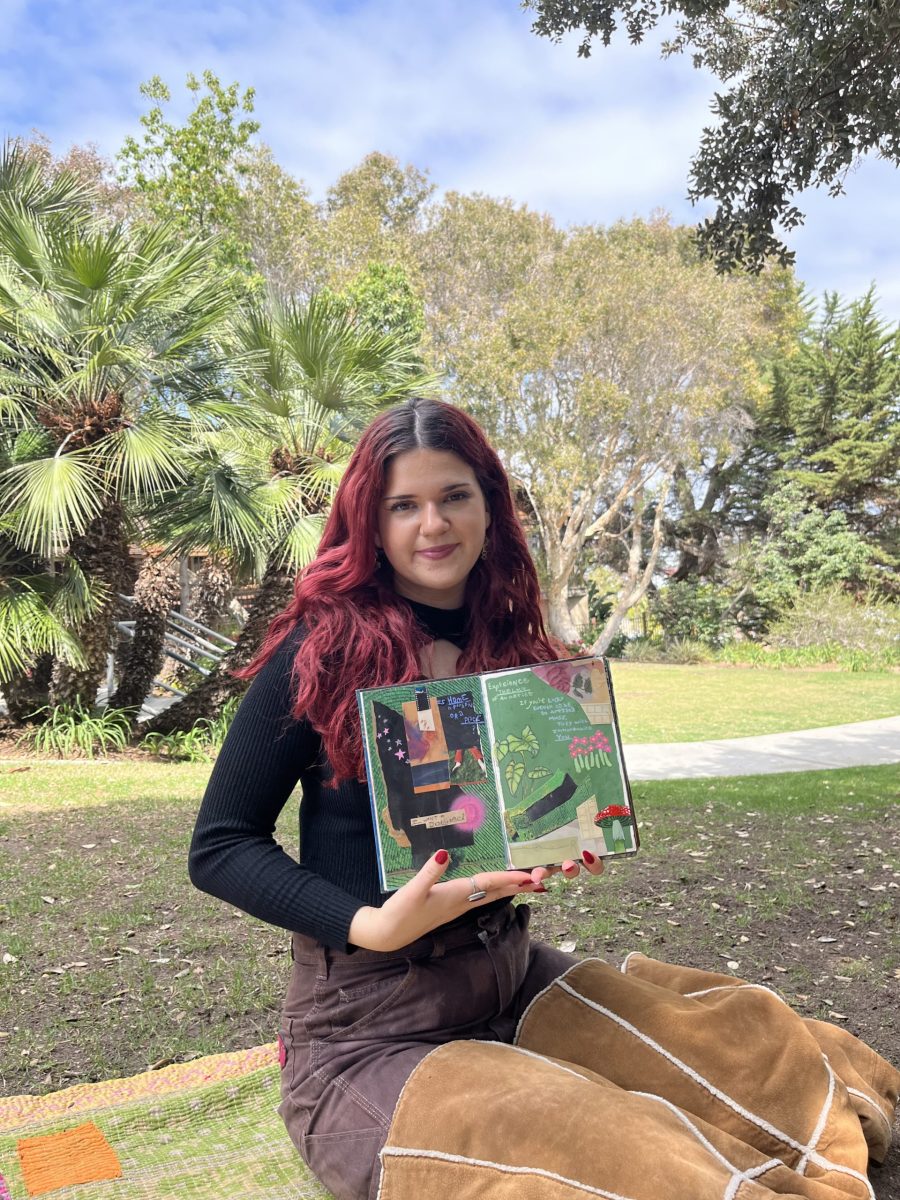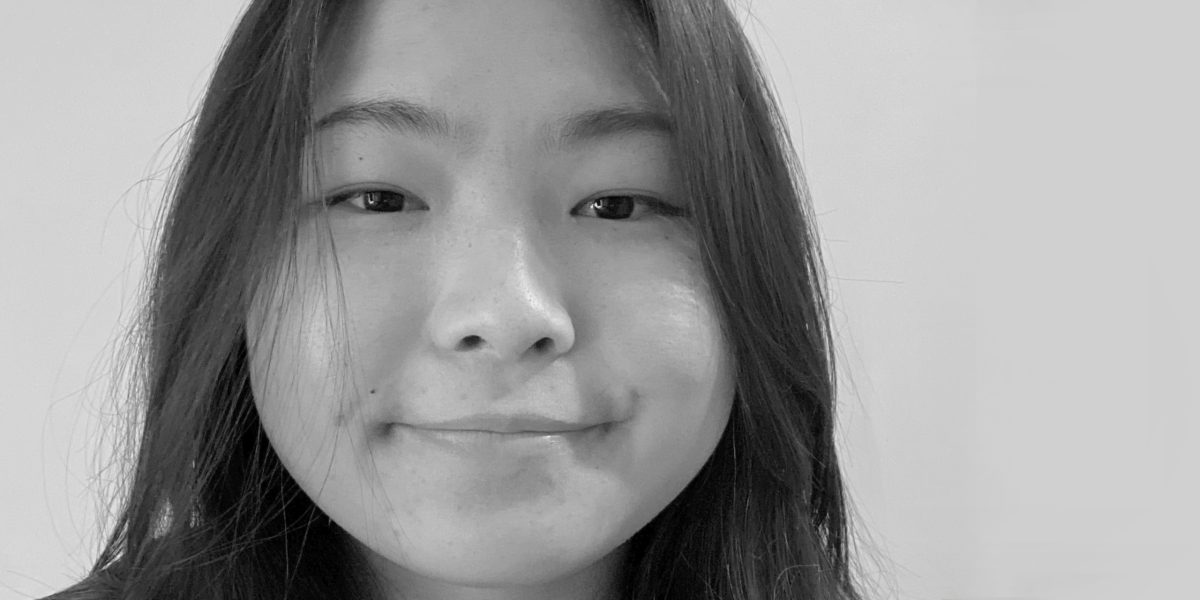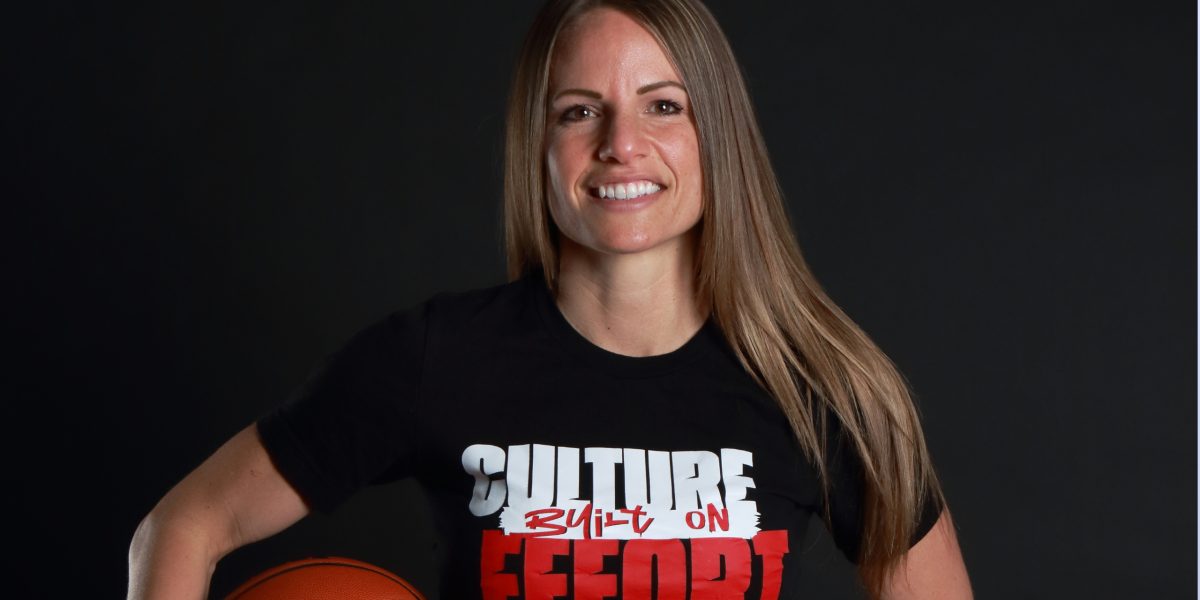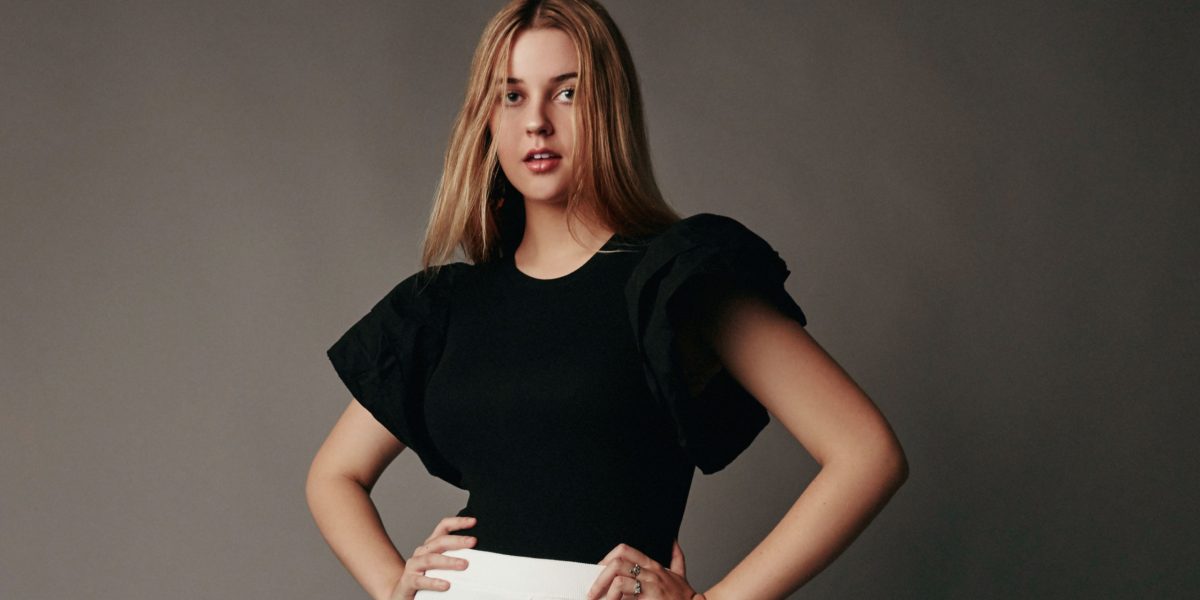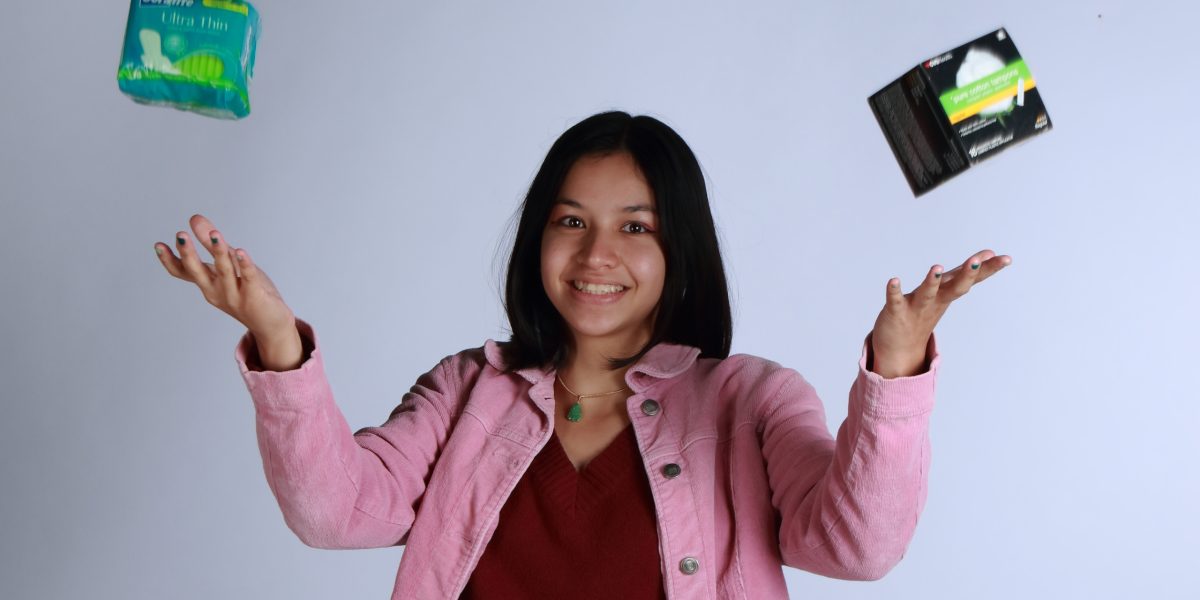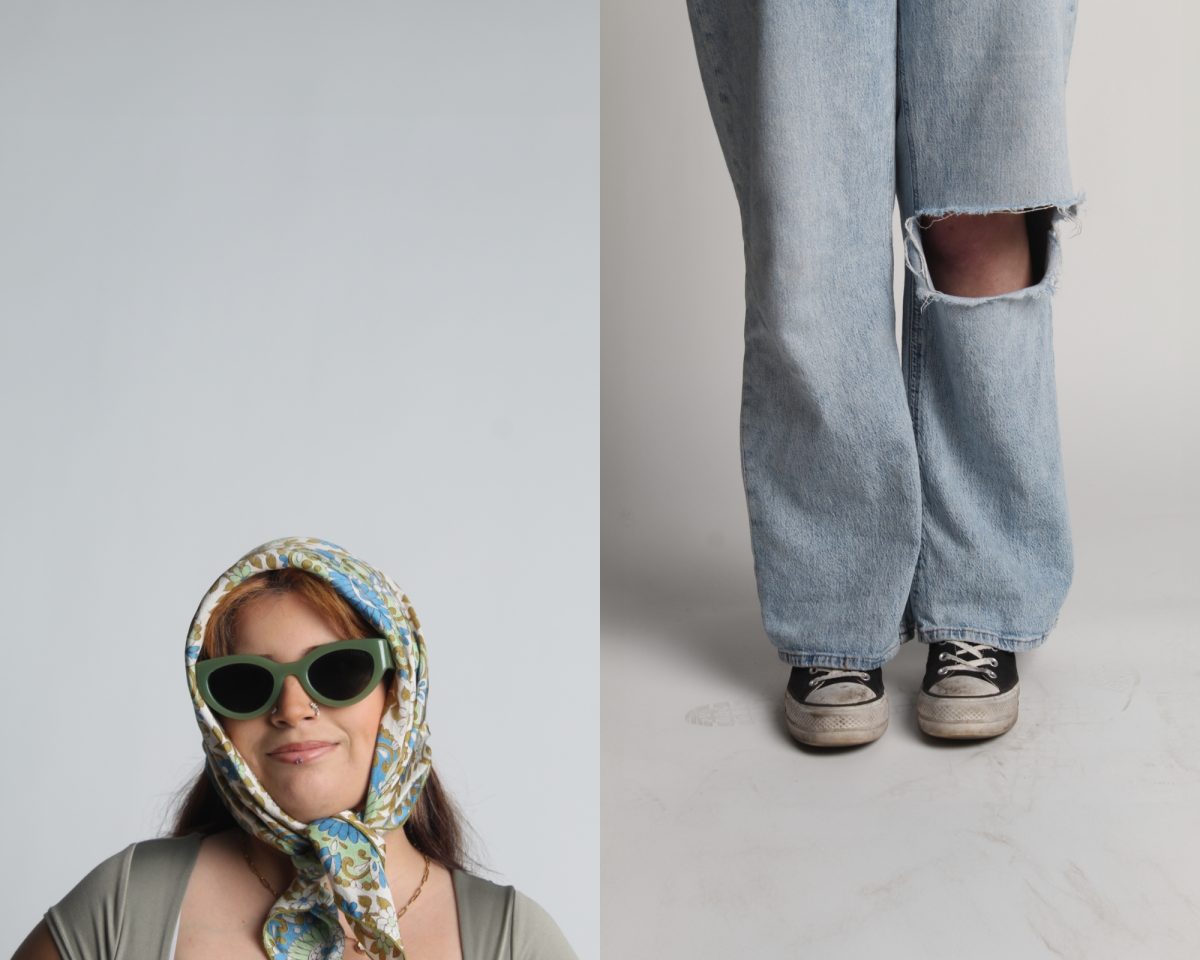Story by Sophia Partida.
The role of a student designer in a world cluttered with clothing
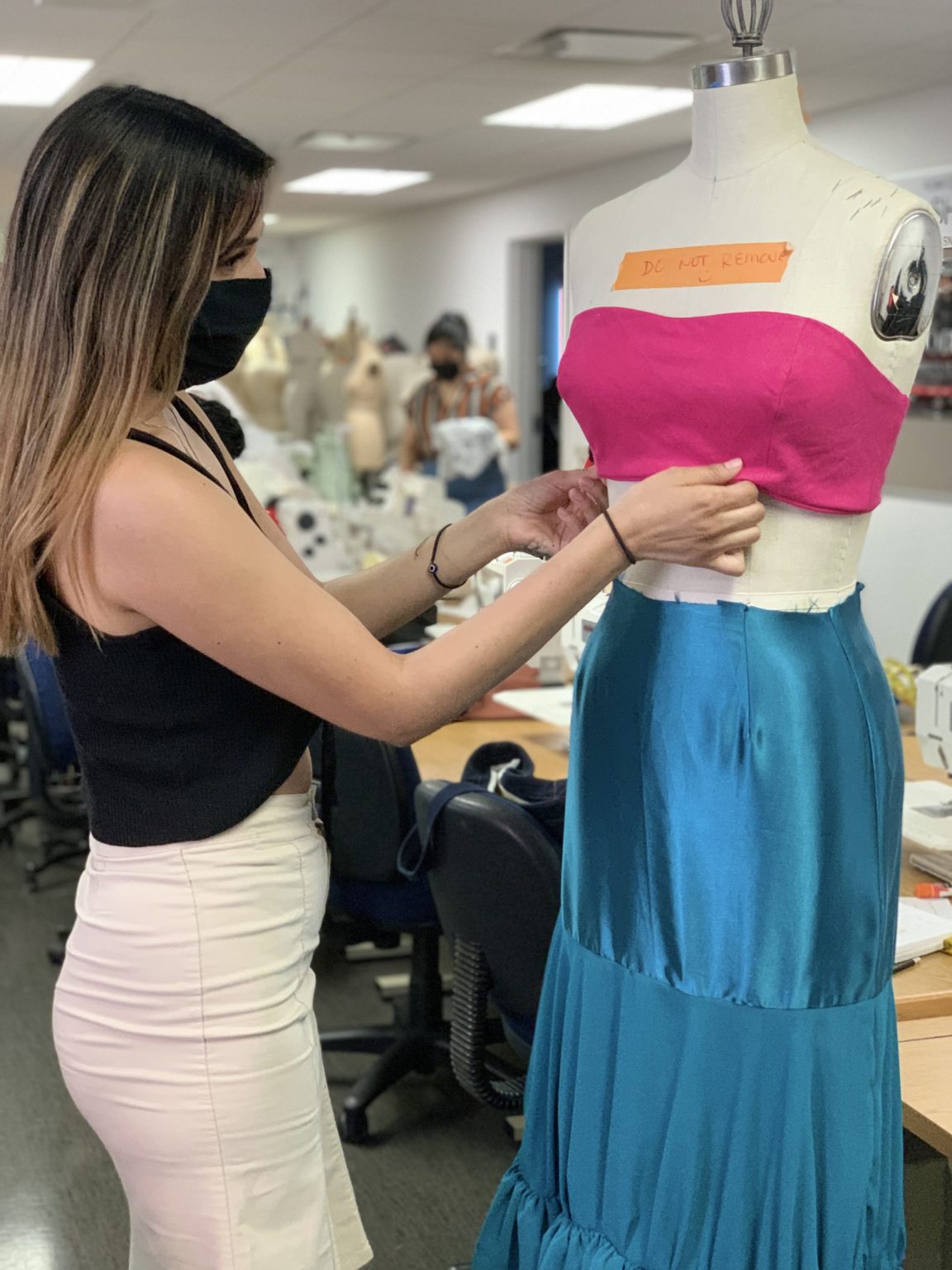
“My style?” She looked down at her clothes. “Very bright,” she replied with a smile. She was wearing a cropped red zip-up sweater, pink and red tie-dye jeans, white shoes and a red shoulder bag. Her color-coordinated outfit may have been seamlessly arranged, but the field of fashion is more complex than it looks.
Alexis Solorio, 22, is majoring in Fashion Design and Merchandising at Palomar College. “Fashion is my creative outlet, it’s my passion and my job,” she said, reflecting her commitment in pushing boundaries, starting with her own clothing. Whether it’s a colorful midi skirt or a masculine outfit with baggy jeans, Solorio enjoys reforming and upcycling pieces, demonstrating that sustainability should be a standard practice.
Growing up in a family-oriented environment allowed Solorio’s artistic abilities to flourish and shaped who she is today. Born in Escondido, California, Solorio and her four brothers were raised by a single mother. “I think my mom is proud that I have something I am passionate about,” Solorio said. Her best friend and cousin, Analicia Saenz, describes her as “talented and creative.” She admired that once Solorio puts her to mind something, she will go above and beyond. Saenz described how Solorio has always liked styling clothes and drawing, which was likely influenced by her mother, who is a preschool teacher.
Inherently artistic, Solorio’s interest in fashion was embraced from a young age. “I’ve always been really into it,” said Solorio, recalling her early fondness for fashion shows. If a character had a unique outfit, she was naturally drawn to them. As a child, one of her favorite toys was a book where you could design clothes and color them with small stencils. Not much has changed, as Solorio still sketches down her ideas for outfits. The only difference is that she can now bring them to life.
“Dear Summer” is the name of her vacation-esque collection for the Fashion Merchandising and Design Program’s annual MODA Fashion Show at Palomar College. You can spot her main influences in these designs: vibrant colors found in nature and tropical themes. “Like this color right here is one of my dresses,” said Solorio, pointing to an arrangement of bright pink flowers next to her.
Ideal for warm weather, her collection mainly consists of dresses and lightweight clothing made of chiffons and silks. Solorio also addresses the changing times we live in and the opportunity to dress up again. “It had a lot to do with COVID, coming out of COVID, not being trapped indoors,” she said, emphasizing that she’s inspired by our freedom to travel again and wear beautiful clothes.
With a full-time job and student responsibilities, Solorio is out the whole day to meet her deadlines. In preparation for the fashion show on May 11, she needs a minimum of five looks in her collection, but she’s been working on the show’s magazine and its production with her advanced design class.
An average day for her starts at 5 a.m., and she usually doesn’t return home until it’s dark outside. Solorio said that the lab has been hectic with the students rushing to complete their designs, but it’s also a very focused and collaborative environment. At the long tables surrounded by dress forms and sewing machines, you’d be able to see her in the afternoon working on colorful garments while sharing tips with her classmates.
This is her last semester after four years at Palomar College, and she hopes to transfer to the Fashion Institute of Technology in New York or the Istituto Marangoni in Paris or London. This field isn’t the most secure, and it explains why one of Solorio’s proudest moments has been her full-time dedication to fashion.
“I feel like this was a hard thing to get into at first…because I’m always that person where it needs to be safe and I have to make money,” said Solorio. However, she feels that this field has opened her up to numerous opportunities and working on her collection has allowed her to learn useful skills.
Although Solorio works in healthcare, her ultimate aspiration is to become a designer with her own label, and she has already started to build a name for herself. In between school, she creates and thinks of various art mediums that will enhance her work in the future. This year Solorio has been styling and creating designs for several women with large followings on social media, gaining experience as she posts them on her Instagram @grlfrienddd.
Coming to campus wasn’t always an option. When Solorio first started her classes, she loved coming to school and experiencing the (essential) hands-on side of designing. Then the pandemic hit.
Since everything had to be done from home, she expressed that it was hard enough to delay her learning process. She said that the teachers have been flexible and were able to catch the students up, but she acknowledged that “there’s always going to be challenges in the fashion industry just because it’s not something that’s safe.”
In the past few years, there’s been a growth in concern over ethical problems in the fashion industry, especially regarding human rights and environmental damage. Is it not possible to appreciate fashion without yielding our moral standards? The United States has one of the largest apparel markets in the world, which makes this crisis only more relevant for us.
Trend Predictions for 2022
Fashion trends shift each season, and soon, new clothes are flooding the market. But if you take a step back, what we are wearing today reveals much more than you would expect about our generation’s mindset. Styles that mimic our adolescence are currently popular.
Still riding off the Y2K wave, we are reaching peak nostalgia with bright colors and youthful silhouettes. Low-rise jeans and skirts have been making a controversial comeback this past year, but Solorio is a fan of the latter. Midi and maxi skirts are must-wear items in her closet this season. Solorio said “flirty and poofy” dresses as a prediction this year but reworked to fit a sleek, modern look.
Traveling further into the past, Regency-style clothing (think puffy sleeves tops) will likely remain for streetwear and runways alike. Whether it’s a bold orange or aquamarine blue, there’s no lack of color this season, so pull out eye-catching prints and accessories to match your unique look.
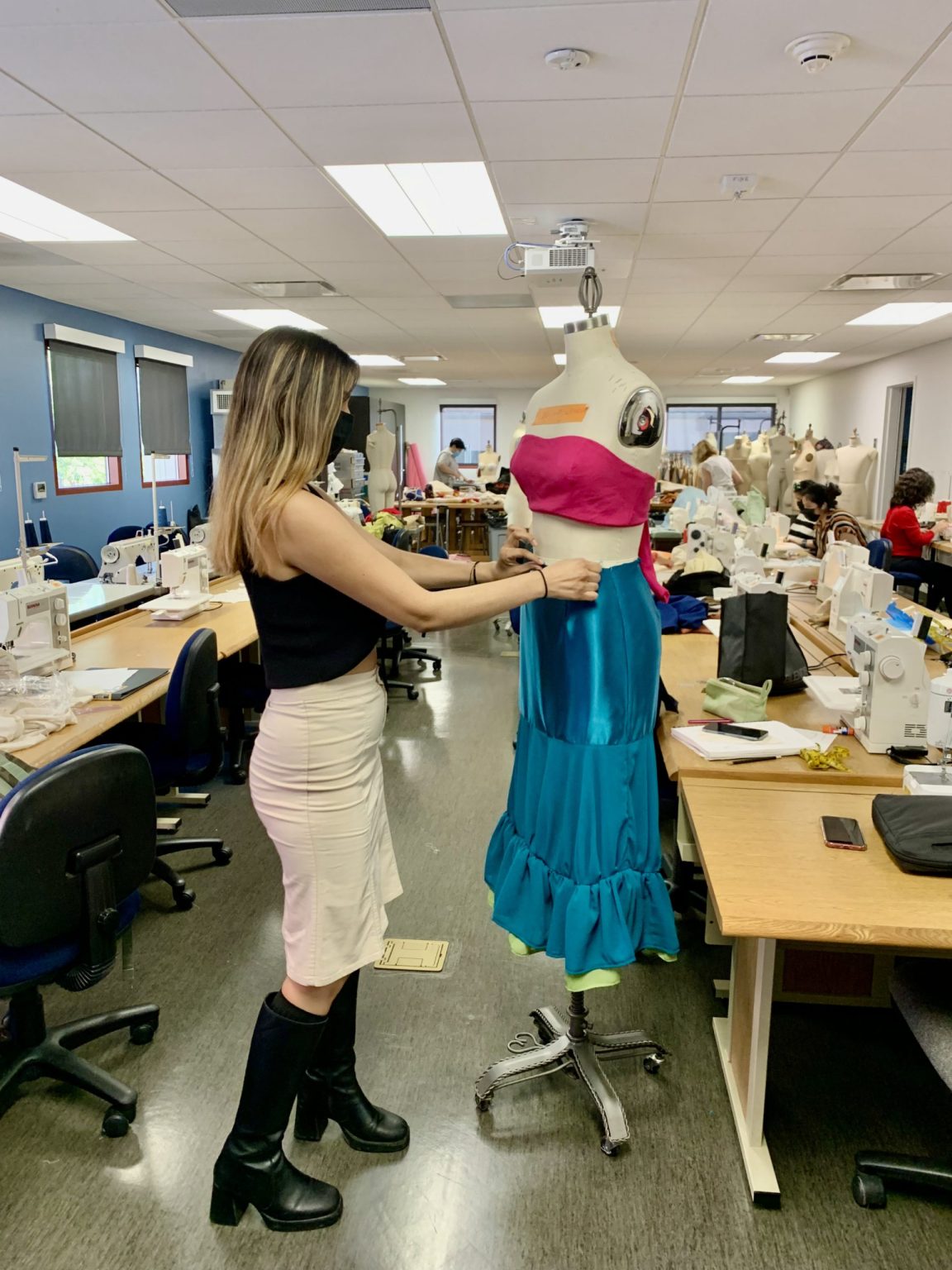
How to Make Fashion More Sustainable
According to the BBC article “Can fashion ever be sustainable?” the fashion industry is responsible for about 8 to 10 percent of global carbon emissions and 20 percent of wastewater. The United Nations estimated in 2018 that a single pair of jeans, made out of one kilogram of cotton, is equivalent to 10 years’ worth of drinking water. The collective consumer desire for new clothes each season has created a monster in the industry: fast fashion. The U.S. Environmental Protection Agency estimated that landfills received 11.3 million tons of textiles and incinerated 3.2 million tons in 2018. The main type of textiles in the municipal solid waste is our own discarded clothing.
Luckily, there’s a way to discover which fashion brands are doing more harm than good. Good On You is an app and website designed to educate consumers by rating thousands of brands based on their treatment of labor groups, animals and the environment. A Good On You spokesperson emphasized that citizens should demand more from brands that aren’t upholding fair labor and eco-friendly standards. Our dangerous shopping habits only encourage the fast fashion industry “while millions of garment workers—the majority being women of colour—are not paid fairly,” Good On You stated.
For student designers, educating yourself is the first step. “Then start with your university department and college peers,” the spokesperson said. “How central is sustainability to your curriculum? How educated are your professors on these issues? Do your students know about the harm ultra fast fashion brands are causing to our environment and to communities around the world? Can you advocate for change where you’re at right now?”
As a consumer, it’s time to stop compromising on trendy, low-priced clothing and finally hold ourselves accountable for what we wear. Professor Monti Ladd is a fashion instructor at Palomar College who commented on three features of this year’s fashion show, one of which is pushing for sustainability. “We are open to upcycling, we encourage it…because we’re celebrating the 75th year of Palomar College,” Ladd said. Since the school’s anniversary is 1946, the instructors urge students to bring back that era with reused clothing.
Solorio is part of the newer generation that is more active in supporting sustainability, starting from her own clothes. “It’s making more room for creativity,” she said. “I definitely would prefer something that is reworked at a thrift store than something I can buy from Shein,” which aligns with the movement against fast fashion companies like Forever 21. It’s necessary to note that we cannot pick and choose which stores to bash while ignoring our (below-par) favorites. There are some stores that enjoy popularity among young adults, but currently have worse ratings than H&M on the Good On You App, including Urban Outfitters, Aerie, Pacsun and Lululemon.
It’s okay to get new clothes and participate in your favorite trends, but remember these vital shopping options: visit vintage and second-hand clothing shops; explore resale sites like ThredUp, Poshmark and Depop; or simply upcycle old clothes. Try to invest in a quality piece you can wear more than a handful of times. Most importantly, don’t trash your clothes once you’re finished with them. Selling clothes online, taking them to donation centers like Goodwill, or simply giving them to a friend will save your conscience and the planet.
Fashion is diverse and imperfect, but it’s home to millions of designers who are facing it with hope. This includes Solorio who wishes to work on various sectors of the industry in the future, while keeping her love for aesthetics and colors. Her time at Palomar College is coming to an end, but the fashion department only gave her a taste of the immense field. She’s ready to learn more.
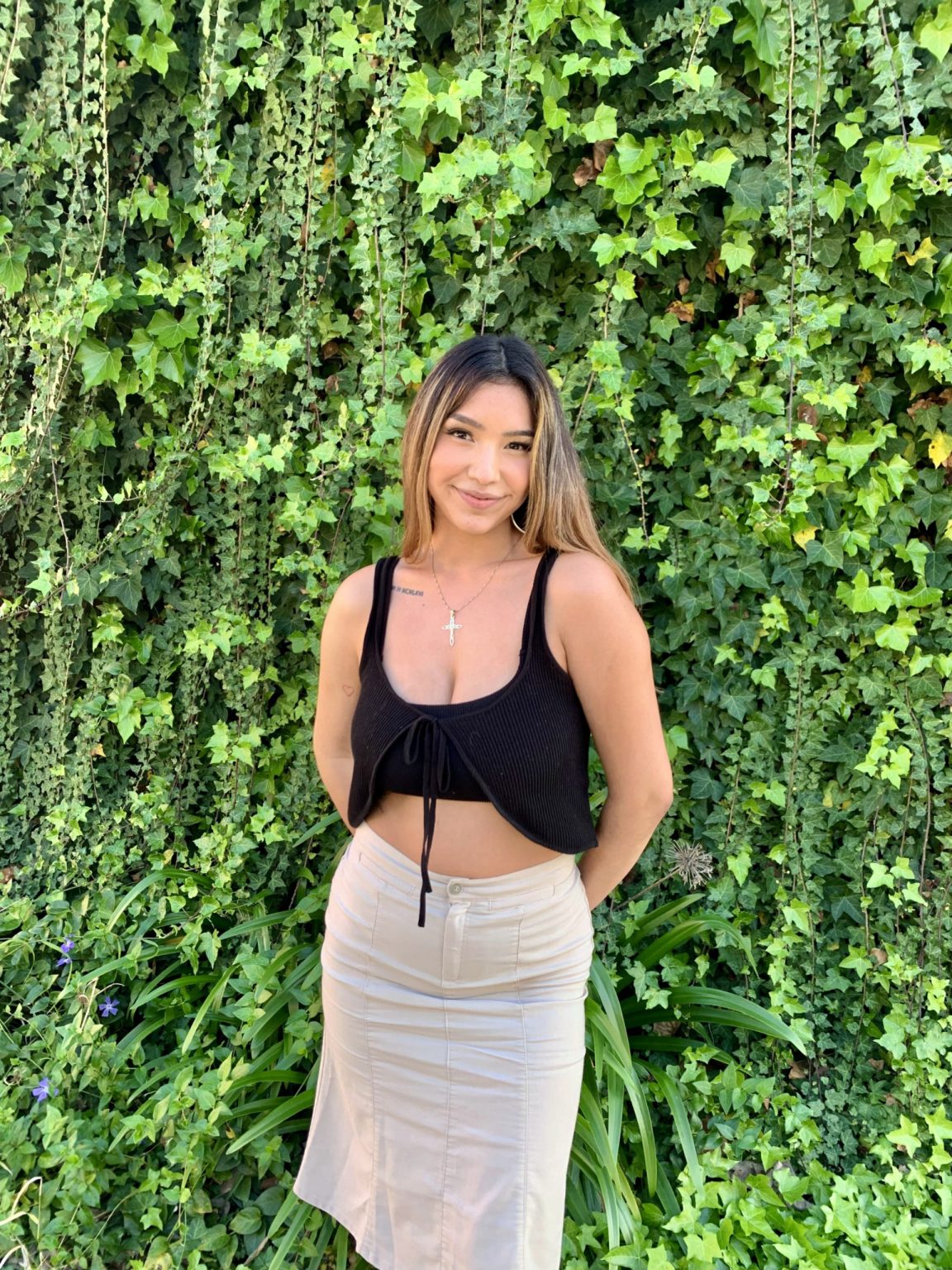
Feature photo courtesy of Marcus Sanchez.

